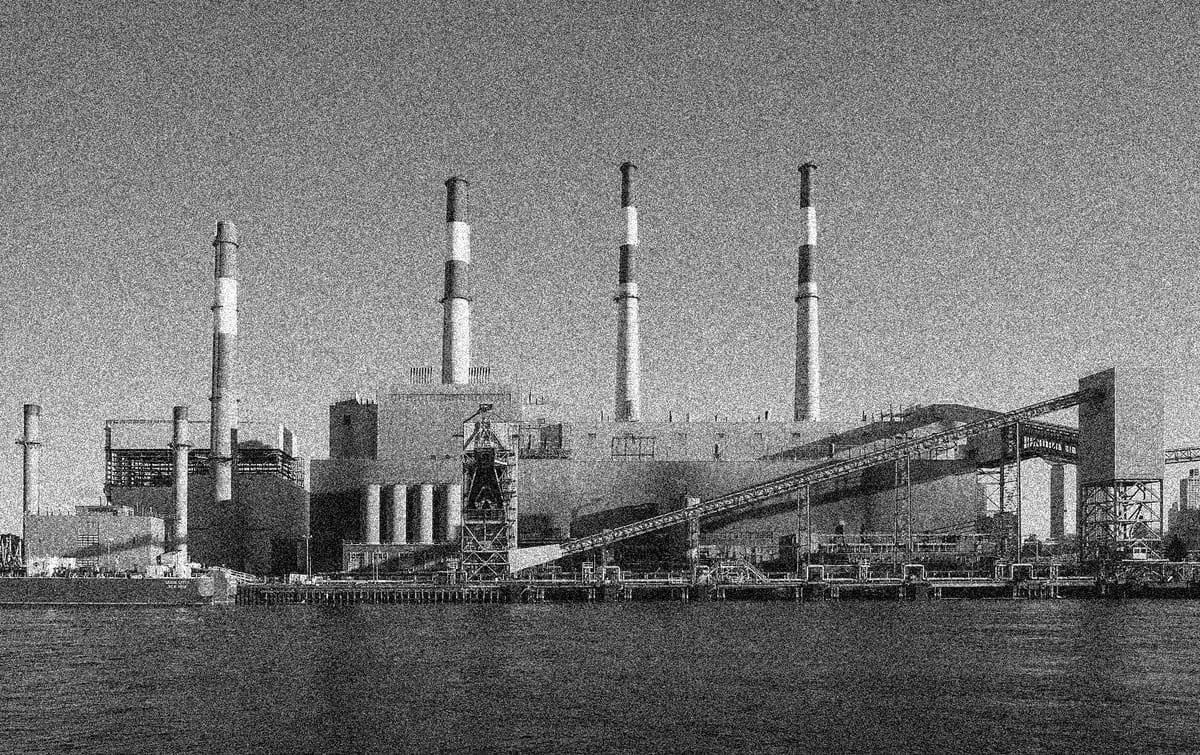Class Divides in the Politics of Building
The turn to a “politics of building” is a welcome change in environmental thinking, but the green Left is still at odds in important ways with the labor movement, which better understands what is needed for deep decarbonization and, most importantly, has the power to help bring it about.

While reading this free article from Matt Huber, consider subscribing to Damage today to get our second print issue, "Deinstitutionalized," fresh off the printer. Along with his co-author Fred Stafford, Matt also has contributed an article to that issue on "The Utility of Utilities."
There appears to be a shift in environmental thinking. A movement most known for blocking destructive fossil fuel infrastructure has realized it also needs a politics focused on building new energy infrastructure: new electricity generation and transmission; new public transit; new energy efficient housing. It’s hard to understate the scale of infrastructure building required to transform a global energy system still 80% dependent on fossil fuels. As Jeremy Corbyn’s Labour Party described it in 2019, it will require a “Green Industrial Revolution.”
This new politics of building has reached the mainstream of liberal and environmental commentary. Perhaps most prominently, New York Times columnist Ezra Klein has called for a “Liberalism that builds,” and climate activist and writer Bill McKibben recently wrote an article for Mother Jones titled, “Yes in our backyards: It’s time progressives like me learned to love the green building boom.”
Although some suggest deindustrialization is an irreversible historical condition the Left must accept—holding out hope for a “new working class” formation based in services and care work—modeling at Princeton University suggests an almost unimaginable scale of industrial construction ahead of 2050 targets for “Net Zero” greenhouse gas emissions. According to the modeling, we need to expand the transmission grid between two and five times, to completely retrofit the steel industry for electric arc furnaces and hydrogen fuel, and to build 250 large (or 3,800 small) nuclear reactors, over 1,000 carbon capture plants and 85,000 km of carbon pipeline infrastructure, and according to Princeton’s Jesse Jenkins, “utility-scale solar projects that cover an area the size of Massachusetts, Rhode Island, and Connecticut combined, and wind farms that span an area equal to that of Illinois, Indiana, Ohio, Kentucky, and Tennessee.”
The Biden administration is at least starting this process by devoting billions in subsidies toward new technologies in need of public support to become commercially viable. Regional “hubs” will concentrate private development around direct air capture and hydrogen fuel, while individually selected facilities will apply new green technologies to clean up extremely carbon intensive sectors of industry like steel, cement, and aluminum.
Yet, as is often the case in climate advocacy, conspicuously absent in this discourse is attention to the role that the builders themselves will play in this new industrial era. We need increased attention on what building trades workers and unions in construction, electricity, transportation, and countless skilled trades like welding, painting, pipefitting, and carpentry think about decarbonization.
It’s clear, of course, that we need these workers to actually do the work of decarbonization—and in fact there’s currently concern about a labor shortage of precisely those workers. But equally important is the question of what strategic role unions and the labor movement might play in advancing this politics of building—and the risks if they end up opposing such an agenda.
The recent return of militancy to the UAW demonstrates the power that unions can bring to bear on this politics. The union’s strike action at the Big Three automakers in the Fall not only won record contracts, but also “just transition” demands. The unprecedented victory in Chattanooga, Tennessee—center of a historically anti-union South—could turn the tide in the same region where much of Biden’s decarbonization investments are located. One would think that centering these workers would be obvious, but it hasn’t been. Ezra Klein has suggested that they are actually inhibitors rather than agents of his liberal politics of building.
…[O]ne of the major challenges of pro-labor politics in the United States is the public perception that unions often slow construction rather than make it better, and that perception is rooted in real failures of real projects in places where liberals and unions hold real power.
Similarly, many climate advocates assert that the building trades unions are barriers to climate action and lament their opposition to flagship climate programs like the Green New Deal. When it comes to the UAW’s historic upsurge, some climate thinkers still worry they are not moving fast enough on decarbonization policies.
Ultimately the antagonism between labor and environmentalists is rooted in the fact that activists predominantly wage campaigns to block or shut down fossil fuel-intensive infrastructure that (like it or not) often entail good, unionized jobs. Additionally, while climate activists tend toward maximalist “bans” on all such infrastructure, fossil fuel workers actually know intimately how reliant our society remains on something like an urban natural gas pipeline network. In the UK, this impasse has led industrial unions to adopt the more practical slogan “Plans not Bans.”
Shifting to a politics of building could possibly, and finally, provide an opening to overcome these antagonisms and create the conditions for a labor-climate coalition. But, at the core of the issue is a deep cultural class divide between climate activists and the workers required to build the energy transition. The climate Left is overwhelmingly made up of professional-class academics, scientists, journalists, and NGO and government staffers. These are quite a different lot than the blue collar workers in the trades who will be at the center of building the energy transition.
To illustrate these dynamics, I was recently in Copenhagen meeting with urban climate activists who all embraced the typical activist lingo about climate justice, solidarity with the Global South and indigenous peoples, and of course imploring countries like Denmark to “degrow.”
I happened to visit on the heels of major Danish elections where the Left did very poorly overall, and one analyst of that election cycle suggested that the industrial wind energy workers, located in particular wind turbine manufacturing and distribution hubs key to Europe’s industry, voted decisively for the Right. If our climate movements can’t even win over wind workers, we have a problem!
Because climate activists are worlds apart from the industrial workers required to build the green energy transition, it is worth getting clear about the basic ideas these workers and unions advance on the topic of climate and decarbonization.
Industrial Unions Accept the Reality of Climate Change
Environmentalists often chide unions for resisting the decarbonization agenda, sometimes implying they don’t fully accept the science of climate change. This is at odds with what the unions actually say.
The Utility Workers Union of America executive Vice President recently wrote, “The UWUA is not a science denying organization. We accept that global warming is a science-based fact, and we all want a clean environment.” They accept that there has to be a transition away from fossil fuels, but they are also concerned about how this transition will affect their already dwindling membership.
In New York City, there is a new plan to turn one of the city’s ancient, hulking gas-fired power plants into a “renewables hub”—transmission infrastructure to receive faraway solar and wind power, battery installations, and a thermal network for heating and cooling nearby buildings. James Shillitto, President of the UWUA Local 1-2, represents 7,000 utility workers in the New York City area. One would think that he and his union would fight such a plan, but he is a loud proponent of the project.
No one can be a climate denier. The trick is to figure out how we do it and keep things going—keep our members working, keep the power flowing… The important thing to know is that these gas-powered plants that will be phased out, they will remain viable because of the infrastructure that is already in place for distribution.
Note his knowledge of the industrial system: building clean energy projects on the sites of old ones makes sense because you can link to existing distribution networks.
Infamously, the AFL-CIO came out in opposition to a Green New Deal. However, their opposition wasn’t grounded in climate denial, but rather frustration that advocates hadn’t reached out to the unions to get their perspective. This is not simply a matter of “checking in” but rather putting unions at the center of policy formulation and movement demands from the start. In his statement regarding the Green New Deal, the late President Richard Trumka said, “We need to address the environment. We need to do it quickly… [and] we need to do it in a way that doesn’t put these communities behind, and leave segments of the economy behind.”
Given electricity’s role as the “linchpin” of decarbonization, the International Brotherhood of Electrical Workers must be at the center of the decarbonization conversation. For their part they see climate change as a possible opportunity:
The power professionals of the IBEW are hard at work building the clean-energy economy of tomorrow. We know that addressing climate change can create good, middle-class jobs that rejuvenate communities across the United States.
And elsewhere they suggest anyone serious about climate change, grid reliability, and union jobs can point to one source of energy in particular: “...nuclear is the only carbon-free source that can ensure around-the-clock generation.” This of course raises another issue entirely as to what technologies we need to ensure decarbonization.
Industrial Unions Advocate an “All of the Above” Approach to Decarbonization
Most people in the climate movement think the energy transition is a straightforward one from fossil fuels to renewables (mostly solar, wind and battery storage), but workers and unions in the energy sector—and indeed most credible scientific bodies—advocate for a much more broad-based approach to decarbonization, often called an “All of the above strategy.”
Climate advocates might oppose unions for calling to keep (unionized) coal plants open—a climate and union friendly alternative does exist in replacing existing coal plants with nuclear power—but broadly speaking there is a much wider set of technologies than just solar panels and wind turbines that unions and scientists believe are necessary for true “deep decarbonization.” At its 2023 convention, the UWUA passed a resolution calling for “Safe and Reliable Electricity”:
Many of the technologies to build the low-carbon energy systems of the future already exist, from using nuclear-fission technology to making small, modular reactors to the use of carbon capture and storage. Energy storage technologies are increasingly viable for widespread application in power grids. Every year, the efficiency of solar and wind generators improves, and the costs fall. Exciting new technology in hydrogen, biomass and other cutting edge technologies present opportunities to create new clean energy and new UWUA jobs.
When climate activists call many of these proposals—carbon capture, hydrogen, and nuclear power—“false solutions,” it is they who depart from the scientific consensus, not unions. If we truly are in a planetary emergency, we can’t be fickle about our technological options. All options must be on the table.
For example, in an article for the leftist outlet Common Dreams entitled, “Climate Groups Reject 'Risky, Untested' Technofixes in IPCC Report,” a spokesperson for environmental NGO Friends of the Earth—the same NGO that wants to shut down California’s reliable and zero-carbon Diablo Canyon nuclear power plant, against the interests of the hundreds of IBEW members who work there—said, “We can't rely on risky, untested, and downright dangerous removals technologies just because big polluters want us to stick to the status quo.”
As emissions keep rising, the necessity of carbon capture technologies only becomes more obvious, but it is clear the opposition from environmentalists is mostly moral and ideological. They believe that the use of such technologies could allow us to continue to burn fossil fuels. They are right that the villains here are those in the fossil fuel industry, but more because they are uninterested in investing in the technology in the first place.
Unions don’t support the “all of the above” strategy purely out of self-interest and member jobs. They also have a deep engineering knowledge of the electricity system. According to Robert Dean, business manager of IBEW Local 1245, “To keep the system running 24-7 through cold weather, hot weather, no sun, night, day, all the time, you have to have a suite of resources.”
John Murphy, International representative of the United Association of Journeymen & Apprentices of the Plumbing and Pipefitting Industry of the United States and Canada and the Clean Energy Jobs Coalition of New York, recognizes that many of these industrial-scale technologies offer much better opportunities for organizing and good union jobs:
Numerous zero-emission technologies are available to enhance efficiency and decarbonize electricity… each of which are reliable 24/7 regardless of weather conditions. These types of green infrastructure generate middle class sustaining jobs and solidifies reliability for years to come.
Union resistance to solar and wind is not purely about grid reliability, but also stems from a deep concern that some “green jobs” are simply not “good jobs.” Labor journalist Lauren Kaori Gurley’s profile of the solar industry reveals dystopian labor conditions: temp agencies like PeopleReady send subcontracted workers from site to site, separated from their family for weeks and exposed to such occupational hazards as extreme heat, alligators, and snakes. And after construction ends, UWUA’s Director of Renewable Energy recently told Damage, “it's hard to find any [wind and solar farms] with union labor in operations and maintenance.”
To be clear, the unions are happy to support renewables when they see it clearly in their interests. Recent research by Keith Brower Brown and Sara Holiday Nelson shows how the IBEW leveraged their power to take advantage of a solar boom in California that offered a steady stream of installation jobs with good wages and benefits.
There’s also other renewable sectors like offshore wind and advanced geothermal that have the potential to take advantage of precisely the same skills as fossil fuel workers—offshore oil and gas workers, or workers who do hydraulic fracturing or fracking need those skills to drill geothermal wells.
Industrial Labor Builds Unique and Strategic Power
If we did resume a “politics of building” and the massive reindustrialization of many left-behind regions, it would be a boon to the labor and union movement more broadly. As Damage contributor Dustin Guastella has argued elsewhere:
Manufacturing is, in fact, special. And this isn’t because these jobs are for macho white men…. It’s because manufacturing, unlike services or agriculture, is the only major industry that has consistently provided unions the ability to build their ranks on the backs of a high-wage bargain.
Manufacturing provides centralized sites of hundreds or even thousands of employees where industrial organizing has historically been quite successful. In the electricity sector, power plants offer the same organizing advantage, in contrast to decentralized power sources like solar panels and wind turbines, but the latter would still be produced at manufacturing centers.
It’s equally clear that the evisceration of the labor movement has come alongside deindustrialization—and the shift of employment toward a more decentralized service sector. Yet when it comes to energy and the power sector, the environmental movement often calls for more not less decentralization, creating inherent spatial and social barriers to labor organizing.
In addition, on account of the aforementioned class divides between the climate activist Left and the industrial building trades, increasingly “Green New Deal” style proposals like public power and “electricity as a human right” or a “Green New Deal for Public Housing” are announced with much activist and media fanfare despite the fact they have zero backing from the actual building trades unions who stand to gain (or lose) most.
The most recent of these was Alexandria Ocasio-Cortez and Bernie Sanders’s green public housing proposal, which featured sponsorships from a panoply of NGOs and service or public sector unions (e.g. teachers), but little in the way of support from the workers or unions actually needed to build the public housing in the first place.
In stark contrast, in a proposal that got far less media attention, the Rhode Island AFL-CIO backed state legislation for public housing in the name of “housing justice” for the poor and working class, but did not center the green or climate angle.
When it comes to actually existing decarbonization projects, it’s easy to see why unions would see more hope in the private sector. Clearly the Biden Administration, whose Inflation Reduction Act is showering tax credits on private sector solar and wind developers and more large-scale industrial decarbonization projects like proposed hydrogen hubs and “green” steel and other industrial projects, agrees. But Biden’s industrial policy might be akin to pebbles in a stream of deindustrialization and manufacturing employment decline. A fighting labor movement should demand more—and call on the public sector to deliver it.
Rebuilding the labor movement probably starts with reviving what labor leader Harry Bridges described as the crucial leverage workers have: “Workers… have one weapon that only they possess and nobody else does, that's the strike weapon.” With deindustrialization there’s been a collapse of strike activity. And we wonder why the labor movement is so weak?
To go back to the case of the UAW: the selective Stand Up Strike tactic against the Big Three automakers was strategically brilliant in disrupting critical supply chains and leaving auto companies uncertain about which industrial plant would be shut down next (while conserving union resources that would be drained quickly in an “all out” strike situation). Deep into the strike, the Financial Times reported that General Motors alone had lost $800 million.
The pressure of the strike also pushed General Motors to agree to do something they claimed was impossible at the start of negotiations: ensure their electric vehicle production plants are included in the UAW union master agreement. In a context of genuine fear about the EV transition harming unions and workers, it took industrial leverage to win a piece of a “just transition.”
What was required to revive this level of militancy and strike action? It took a rank-and-file reform caucus to do the slow and boring organizing work of changing union election procedures leading to the election of new, militant leadership. Although the new leadership only took power in March, it didn’t take long for them to use their leverage, go on strike, and force the employers to deliver record gains.
The unprecedented landslide unionization victory at the Volkswagen plant in Chattanooga, Tennessee is the latest product of this organizing (and it’s worth pointing out the plant includes electric vehicle production). If UAW can score more victories in a decarbonizing auto sector, that means more workers and more communities will associate climate action with improved lives and worker power. This is, or should be, the theory of change behind a Green New Deal.
The shift to a politics of “building” is a welcome one in environmental thinking. But in order to bring it to fruition we must center the workers who will do the building. Their vision of decarbonization is one that entails large-scale reindustrialization that could revive communities across the country hollowed out by disinvestment and capital flight. They also are the ones with the power to bring this about.
■
Matt Huber is a professor in the Department of Geography and the Environment at Syracuse University. He is the author of Climate Change as Class War: Building Socialism on a Warming Planet.



